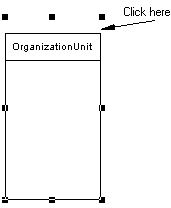

Chapter 4 Building Business Process Diagrams
You can modify an object's properties from its property sheet. To open an organization unit property sheet, double-click its diagram symbol or its Browser entry in the Organization Units folder.
To double-click a swimlane, position the cursor above the symbol until you see a vertical arrow pointing to the frame, click to display a selection frame around the symbol, and then double-click the zone in the selection frame above swimlane.

The following table details the General tab that contains the properties most commonly entered for organization units:
| Property | Description |
|---|---|
| Name | Specifies the name of the item, which should be clear and meaningful, and should convey the item's purpose to non-technical users. |
| Code | Specifies the technical name of the object, which is used for generating code or scripts. |
| Comment | Specifies a descriptive comment for the object. |
| Stereotype | Extends the semantics of an object derived from existing objects but specific to your needs. You can type stereotypes directly in this field, or add stereotypes to the list by specifying them in your model's resource file or in an extended model definition. An organization unit has the following predefined stereotypes:
|
| Parent organization | Specifies another organization unit as the parent to the current one. Each time an organization unit is selected in this list, it becomes the parent of another organization unit, the latter becoming the child. For example, you may want to describe an organizational hierarchy between a department Dpt1 and a department manager DptMgr1 with DptMgr1 as parent organization of Dpt1. This relationship is also displayed in the Organization Units sub-tab of the Dependencies tab in the property sheet of the child organization unit. |
| Copyright (C) 2008. Sybase Inc. All rights reserved. |

| |